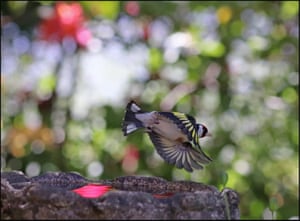I’ve spent most of my working life photographing people and places. Usually on film in glorious black and white. Being locked down has forced me to take a closer look at my surroundings.
When I was away on assignments, my wife found time in her own busy life to make a beautiful garden. Since Patricia died seven years ago, I have come to appreciate the wonderful legacy she left me.




I never seemed to have time to study the birdlife around me before; I just liked the idea they were around and I enjoyed their dawn chorus over the years.
In a fairly small space I am pleased to be visited regularly by many species of bird.
My friendly robins follow me around listening to my mutterings (they later bring some of their youngsters), but most of the birds are extremely shy and need coaxing with refreshments to stay around. Now, during my isolation vigil, I watch them as carefully as I did when photographing people.

I know very little about birds but admire their grace and beauty.
I became intrigued by the behaviour of the goldfinches with their vivid striking colours who come to feed and drink. Extraordinary things happen. They love the sunflower hearts I put out for them, but they defend their territory jealously, often squabbling in what seems a frightening show. But that is what it is: a show. In minutes they are all best mates, although other species are unwelcome at the feeders. They are fiercely repelled whenever they try to share. Then, strangely, different species will often gather at the water feature at the same time and seemingly tolerate each other.



A gathering of goldfinches is aptly called a charm, and they have charmed their way through the ages and appeared in many Renaissance paintings, including a Raphael masterpiece. The birds are often linked to paintings as theological symbols. Recently, a famous goldfinch painting became the subject of a Pulitzer prize-winning novel. Thomas Hardy believed in protecting the birds from cruel imprisonment, and The Caged Goldfinch is in one of his collections of poems.
My grandfather’s generation loved the birds so much they sadly just had to capture and cage them. So fond were they that, when the birds died, they were sought-after taxidermy specimens, placed under glass domes to be admired.


But now that I can admire them from afar with a telephoto lens, I notice, never before as intensely, the beautiful displays revealed in flight, which is mostly at the speed of light. They arrive, settle to feed or sip from the birdbath, and then in a fraction of a second they are gone. I set myself a challenge to capture those missing seconds. It often took me days to arrest just one of those wonderful moments of takeoff and flight – something normally almost invisible to us. A blink and you’ve missed it.

It was so rewarding to see the graceful movements and displays of perfectly designed plumage. Sometimes – I’m either getting quicker or luckier – I manage a shot before they disappear out of frame. So many near misses, though. I just use the camera I have at hand – digital now, of course, after almost a lifetime with film. I don’t have a hide, I just sit quietly on an old bench and try to merge into the background.
The garden with azaleas and rhododendrons in bloom often makes an almost impressionistic backcloth for my new airborne friends.

Blue tits find tasty food in my apple blossom, and they love to bring their young to bathe. The juveniles treat this opportunity like a lido and dive in without a care, coming up for air after being completely submerged and looking like dishevelled kids who have had a really good time. This is until a gang of young house sparrows arrive to fill the pool.

A greenfinch calls, then a nuthatch with a streamlined profile swoops across. Long-tailed tits bring their youngsters to share the fun with house sparrows who are determined to get into the frame, and the blackbird leaves his singing perch on the silver birch to take a dip. So, all around me, nature carries on, oblivious to our own terrible, serious problem.
